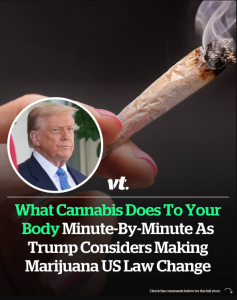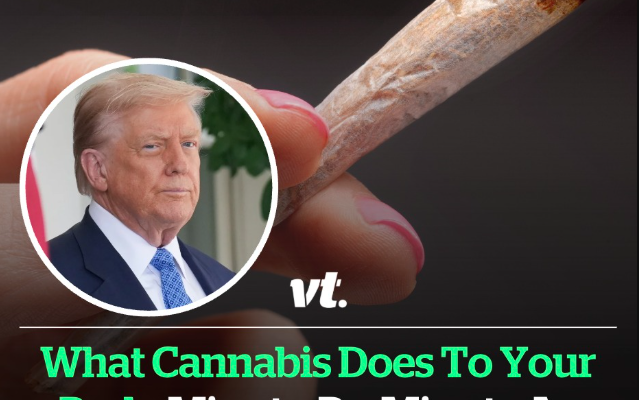Trump’s Marijuana Law Consideration
In early August 2025, multiple reports indicated that President Donald Trump is weighing a change in federal marijuana laws, potentially easing restrictions or even moving toward legalization. This comes amid growing bipartisan pressure, public opinion shifts, and the economic lure of cannabis taxation. Advocates argue that legalization could reduce criminal justice burdens, create jobs, and regulate a booming market. Critics warn of public health implications and regulatory complexities.
While policy debates rage, many Americans remain curious: What exactly happens in the body after consuming cannabis? Below is a scientific, minute-by-minute timeline.
Minute-by-Minute Cannabis Effects on the Body
0–1 Minutes (Inhalation or Vaping)
If cannabis is smoked or vaped, cannabinoids—especially THC (tetrahydrocannabinol)—enter the lungs and diffuse into the bloodstream almost instantly. From there, THC travels to the brain within seconds, binding to cannabinoid receptors in the endocannabinoid system. This is why inhaled cannabis has such a rapid onset compared to edibles.
2–5 Minutes
Early effects begin: mild euphoria, changes in sensory perception, and a slight increase in heart rate (10–20 beats per minute above baseline). Some users may experience a light, floaty feeling or heightened appreciation for colors, sounds, and textures. For inexperienced users, this stage can bring anxiety if too much THC is consumed.
5–10 Minutes
The psychoactive effects intensify. Dopamine release increases, contributing to feelings of relaxation, creativity, or giddiness. The body may experience reduced muscle tension, and pain perception can begin to shift. This is also when short-term memory function becomes more noticeably affected.
10–20 Minutes
Peak euphoria may occur during this window for many inhalation users. Visual and auditory stimuli may feel more engaging. Appetite signals can start firing—this is the early stage of the “munchies.” Some individuals may also experience altered time perception, with minutes feeling like much longer intervals.
20–30 Minutes
THC’s influence on the hippocampus and prefrontal cortex becomes more apparent, potentially impairing short-term recall and complex decision-making. Emotional responses can be intensified, meaning positive moods can feel amplified, but stress or paranoia can also become more pronounced in sensitive users.
30–60 Minutes
For inhaled cannabis, the most intense psychoactive effects generally stabilize. Physical sensations such as dry mouth (“cottonmouth”), red eyes (from dilated blood vessels), and mild motor coordination impairment are common. Pain relief, if sought, is usually at its peak.
60–90 Minutes
Gradual comedown begins for many, but cognitive effects may still be noticeable. Appetite tends to remain elevated, and social interaction may feel more relaxed or amusing. Reaction time and motor skills remain impaired—one reason why driving under the influence is dangerous and illegal.
Edible Cannabis Timeline (for comparison)
Because edibles are metabolized differently—THC is processed in the liver into 11-hydroxy-THC, a more potent and longer-lasting compound—the timeline shifts.
0–30 Minutes
Minimal to no effect as digestion and absorption occur.
30–60 Minutes
Early onset: mild relaxation or mood changes. Some users feel nothing yet.
60–90 Minutes
Effects can ramp up quickly. Euphoria and altered perception may come on suddenly, sometimes catching inexperienced users off guard. This delayed onset is why overdosing with edibles is common—people assume it “isn’t working” and consume more too soon.
90–180 Minutes
Peak effects: Strong body high, intense sensory changes, and altered thought patterns. Coordination and reaction times are significantly reduced.
3–6 Hours
Gradual comedown, with residual effects lasting much longer than smoking or vaping.
Physiological Effects in Key Systems
-
Cardiovascular: Increased heart rate, temporary changes in blood pressure. For those with preexisting heart conditions, this can be risky.
-
Respiratory: Smoking can irritate the lungs, though vaporizing reduces combustion-related toxins.
-
Neurological: Alters neurotransmitter activity, affecting mood, memory, and motor coordination.
-
Digestive: Stimulates appetite and may ease nausea—beneficial for chemotherapy patients.
-
Immune System: Some evidence suggests cannabis has anti-inflammatory properties, though long-term immune effects are still under study.
Risks & Considerations
-
Impaired driving and accidents due to slower reaction times.
-
Anxiety or paranoia, especially in high doses or high-THC strains.
-
Dependency risk, though lower than alcohol or nicotine, is still present.
-
Impact on adolescent brain development if used heavily before age 25.
Why Trump’s Policy Shift Matters
If President Trump moves toward easing marijuana restrictions:
-
Federal vs. State Conflict could shrink—currently, marijuana remains federally illegal despite state legalization in 24 states.
-
Banking and Business Growth: Federal legalization would open financial services to cannabis businesses.
-
Criminal Justice Reform: Could reduce arrests and incarceration for non-violent cannabis offenses.
-
Medical Research Expansion: Rescheduling cannabis would allow broader, federally funded clinical studies.
Trump has not committed to full legalization but has hinted at “common-sense reform,” possibly reclassifying cannabis to allow medical use nationwide and deferring to states on recreational sales.
The Takeaway
Cannabis affects the human body quickly when inhaled and more slowly but intensely when eaten. From a physiological standpoint, it interacts with a vast network of cannabinoid receptors, influencing everything from mood to pain perception. With Trump considering a potential federal policy change, the conversation about cannabis is shifting from taboo to mainstream political debate. If legalization or reclassification occurs, the U.S. could see major cultural, medical, and economic changes—alongside the continued need for education on safe use.




